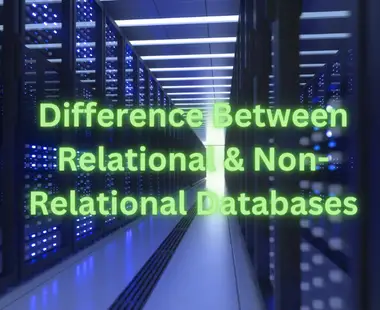The difference between relational and non-relational databases is important for the anyone work with data. Both types of databases serve different purposes and have distinct advantages. In this article, we will discuss the major differences, helping you to decide which one is right for your development process.
What are Relational Databases?
Relational databases organize data into tables. Each table consists of the rows and columns, where each row represents a record and each column represents a data attribute. This structure makes it is easy to manage and query data. Popular relational databse management systems are MySQL, PostgreSQL, and Oracle.

Key Features of Relational Databases:
- Structured Data: Data is stored in a highly structured format, making it ideal for applications that require complex queries.
- ACID Compliance: Relational databases follow ACID (Atomicity, Consistency, Isolation, Durability) properties, ensuring reliable transactions.
- Schema-Based: A predefined schema dictates the structure of the data, which enforces data integrity and relationships between tables.
What are the Non-Relational Databases?
Non-relational databases, also known as NoSQL databases, do not use tables to store data. Instead, they are use various data models like document, key value, column family, and graph. MongoDB, Cassandra, and Redis are the some examples of non-relational databases.
Key Features of Non-Relational Databases:
- Flexible Schema: They can store unstructured, semi-structured, or structured data, allowing for more flexibility.
- Scalability: Non-relational databases are designed to scale out by distributing data across multiple servers.
- Performance: They can handle large volumes of data and high traffic loads, making them suitable for big data applications.
Main Differences Between Relational & Non-Relational Databases
- Data Structure:
- Relational: Uses a fixed schema with tables, rows, and columns.
- Non-Relational: Flexible schema; can use documents, key-value pairs, graphs, etc.
- Scalability:
- Relational: Typically scales vertically by adding more power to the existing server.
- Non-Relational: Scales horizontally by adding more servers to distribute the load.
- Query Language:
- Relational: Uses Structured Query Language (SQL) for defining and manipulating data.
- Non-Relational: Uses various query languages depending on the database type.
- Transactions:
- Relational: Supports complex transactions and ensures ACID compliance.
- Non-Relational: May offer eventual consistency, with some providing ACID compliance at the expense of performance.
- Use Cases:
- Relational: Suitable for applications needing complex queries and transactions, like banking systems.
- Non-Relational: Ideal for applications with large amounts of unstructured data, like social media platforms.

How to choose best database type for your project
When you deciding between the relational and non-relational databases, consider the specific needs of your application. If you require complex queries and transactions, a relational database is likely a best choice. However, if you need to the handle large volumes of unstructured data and require high scalability, non-relational database might be more suitable.
Now you have a solid understand about the difference between relational and non-relational databases. It will helpful for you when you want to choose a database for your project. If you have any question please put in this below comment section. Good bye!!!


